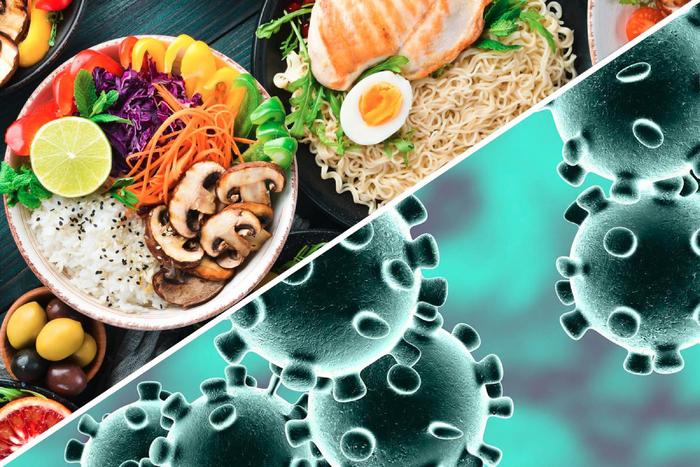Can Viruses Be Transmitted Through Food and Water?

This article examines the potential transmission of viruses through food and water. It explores the common viruses that can be found in these sources and the routes through which they can be transmitted.
Additionally, the factors influencing the survival of viruses in food and water are discussed. The article also outlines the symptoms and prevention of foodborne viral illnesses and the risks and precautions associated with waterborne viral infections.
Finally, safety measures for preventing viral contamination in food and water are presented.
Key Takeaways
- Norovirus and hepatitis A are common viruses found in food and water sources.
- Contaminated food sources can transmit viral infections through raw or undercooked food.
- Waterborne viral infections occur when individuals consume contaminated water.
- Temperature and water treatment methods play crucial roles in determining the survival and inactivation of viruses in food and water.
Common Viruses Found in Food and Water
Various common viruses, such as norovirus and hepatitis A, have been detected in food and water sources, posing potential risks for transmission. These common viral strains can contaminate food and water through various transmission methods.
For instance, norovirus can be transmitted through direct contact with infected individuals or by consuming contaminated food or water. It can survive in water sources and cause outbreaks when ingested.
Similarly, hepatitis A can be transmitted through the consumption of contaminated food or water, particularly in areas with poor sanitation practices. Both viruses can cause gastrointestinal symptoms, such as vomiting and diarrhea, and can lead to outbreaks in communities or healthcare settings.
Understanding the presence of these common viral strains in food and water sources is crucial for implementing effective preventive measures to reduce transmission risks.
Routes of Viral Transmission Through Food and Water
This discussion will focus on two key points: contaminated food sources and waterborne viral infections.
Contaminated food sources can serve as vehicles for the transmission of viral infections, as viruses can be present in raw or undercooked food.
Waterborne viral infections, on the other hand, occur when individuals consume water that has been contaminated with viruses, typically due to inadequate sanitation or poor water quality.
Contaminated Food Sources
Contaminated food sources have been identified as potential vectors for the transmission of viruses. Viruses can be present in various types of food, including fruits, vegetables, meat, seafood, and even water.
The contamination of food sources can occur at any stage, from production to preparation and consumption. Food safety measures are crucial in preventing viral transmission through contaminated food. These measures include proper handling, storage, and cooking of food, as well as ensuring the cleanliness and hygiene of food processing facilities and equipment.
Additionally, regular monitoring and testing of food sources for viral contaminants are essential for early detection and prevention of outbreaks. Implementing strict food safety protocols and educating the public about safe food handling practices are vital in reducing the risk of viral transmission through contaminated food sources.
Waterborne Viral Infections
Waterborne viral infections pose a significant public health concern, as they can lead to widespread outbreaks and have a substantial impact on affected populations. Water is a vital resource for human survival, but it can also serve as a medium for the transmission of viruses.
Waterborne viral outbreaks can occur through various routes, including contaminated drinking water, recreational water, and water used in food production and processing. Viral contamination risks in water sources can arise from inadequate treatment processes, improper sewage disposal, and contamination from human or animal feces.
Common waterborne viral infections include norovirus, rotavirus, and hepatitis A virus. These viruses can cause gastrointestinal symptoms such as diarrhea, vomiting, and abdominal pain.
Adequate water treatment, proper sanitation practices, and public education are essential in reducing the risk of waterborne viral infections and preventing their associated outbreaks.
Factors Affecting Virus Survival in Food and Water
The survival of viruses in food and water is influenced by various factors, including temperature and water treatment effectiveness.
Temperature plays a crucial role in determining the survival and inactivation of viruses, as higher temperatures can accelerate the degradation of viral particles.
Additionally, the effectiveness of water treatment methods, such as disinfection and filtration, can impact the removal or inactivation of viruses present in water sources.
Understanding the impact of temperature and water treatment effectiveness on virus survival is important for ensuring the safety of food and water supplies.
Temperature Impact on Survival
Temperature fluctuations can significantly influence the survival rate of viruses in food and water. The effect of temperature on viral viability is well-documented and has important implications for food safety and public health. Viruses are sensitive to temperature changes, and their survival is influenced by factors such as the type of virus, the initial viral load, and the duration of exposure. High temperatures can lead to the inactivation or destruction of viruses, while low temperatures can prolong their survival.
To illustrate the impact of temperature on viral viability, the following table presents examples of the effect of different temperature ranges on the survival of selected viruses in food and water:
| Virus Type | Low Temperature Range (°C) | High Temperature Range (°C) |
|---|---|---|
| Norovirus | 0-4 | 60-63 |
| Hepatitis A | -20 to -70 | 85-100 |
| Rotavirus | 4-8 | 50-60 |
It is evident from the table that different viruses have varying temperature ranges for survival, emphasizing the importance of considering temperature effects when assessing the risk of viral transmission through food and water.
Water Treatment Effectiveness
Water treatment methods play a crucial role in reducing the risk of viral contamination in water sources. With the emergence of new waterborne viruses, advancements in water treatment technology have become essential to ensure the safety of drinking water.
These advancements include the use of disinfection techniques such as chlorination, ultraviolet (UV) irradiation, and ozone treatment. Chlorination, the most widely used method, effectively inactivates a wide range of waterborne viruses. UV irradiation is also effective against many waterborne viruses by damaging their genetic material. Ozone treatment, on the other hand, not only disinfects water but also removes odor and taste.
However, it is important to note that some emerging waterborne viruses, such as norovirus and enterovirus, may be resistant to traditional water treatment methods. Therefore, continuous research and development of water treatment technologies are necessary to effectively combat the threat of these emerging waterborne viruses.
Foodborne Viral Illnesses: Symptoms and Prevention
Foodborne viral illnesses can lead to various symptoms and can be prevented through proper food handling and hygiene practices.
Symptoms management is crucial in preventing the spread of viral illnesses through contaminated food. Common symptoms of foodborne viral illnesses include nausea, vomiting, diarrhea, abdominal pain, and fever. In some cases, more severe symptoms such as dehydration, muscle aches, and respiratory distress may occur. It is important to note that the specific symptoms may vary depending on the type of virus involved.
To control the spread of viruses, it is essential to implement strict hygiene practices in food preparation and handling, such as regular hand washing, proper cooking and storage temperatures, avoiding cross-contamination, and using safe water sources.
Additionally, educating food handlers and consumers about proper food safety practices plays a critical role in preventing foodborne viral illnesses.
Waterborne Viral Infections: Risks and Precautions
Public health measures and adequate sanitation practices are essential in preventing the spread of waterborne viral infections. Waterborne viral infections are a significant public health concern worldwide. Various factors contribute to the transmission of these infections, including contaminated water sources and poor sanitation practices.
To address this issue, several water quality standards and regulations have been implemented to ensure the safety of drinking water. These regulations focus on monitoring and treating water supplies to eliminate or minimize the presence of viruses.
Additionally, public awareness campaigns and educational programs are essential to promote proper hygiene practices and raise awareness about the risks associated with waterborne viral infections.
Effective prevention and control strategies are crucial in reducing the burden of waterborne viral infections on public health.
Safety Measures for Preventing Viral Contamination in Food and Water
Contaminants in food and water pose significant health risks, necessitating the implementation of safety measures to prevent viral contamination. Preventing contamination in food and water is of paramount importance to protect public health. This can be achieved by adhering to rigorous food safety standards.
Several measures can be taken to prevent viral contamination in food and water. These include proper hygiene practices during food handling and preparation, such as handwashing and sanitizing surfaces and utensils. Additionally, maintaining proper storage temperatures and ensuring the cleanliness of water sources are crucial in preventing viral contamination.
Regular monitoring and testing of food and water samples can also help identify and address any potential sources of contamination. By implementing these safety measures, the risk of viral transmission through food and water can be significantly reduced, safeguarding public health.
Frequently Asked Questions
Can Viruses Be Transmitted Through Non-Potable Water Sources Like Swimming Pools or Lakes?
Non-potable water sources, such as swimming pools or lakes, may potentially transmit viruses. It is crucial to consider swimming pool safety and the risk of waterborne diseases when using these facilities.
What Are the Differences Between Viral Infections Transmitted Through Food and Those Transmitted Through Water?
Differences between foodborne and waterborne viral infections arise from the distinct routes of transmission. While foodborne viruses are ingested, waterborne viruses are typically acquired through ingestion or contact. Cooking and boiling food can reduce viral transmission, but water treatment is necessary to eliminate waterborne viruses.
Can Viruses Survive in Dry Food Products, Such as Grains or Cereals?
The survival of viruses in dry food products, such as grains or cereals, has implications for the potential risks associated with consuming contaminated food. Understanding the factors that influence viral contamination is crucial for ensuring food safety.
Are There Any Specific Foods or Beverages That Are More Susceptible to Viral Contamination?
The susceptibility of specific foods and beverages to viral contamination is an important consideration in understanding the transmission of viruses through food and water. Understanding which foods and beverages are more prone to viral contamination can help in developing effective prevention strategies.
How Long Can Viruses Survive in Water or Food if Proper Storage or Refrigeration Measures Are Not Taken?
The long-term survival of viruses in water or food and the impact of temperature on virus survival in food or water are important considerations in understanding the potential transmission of viruses through these mediums.









